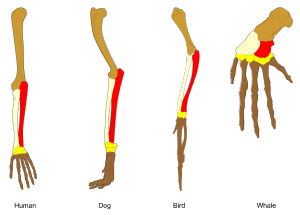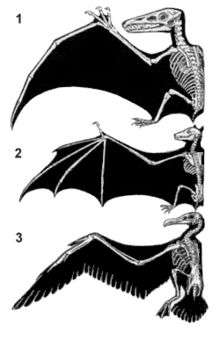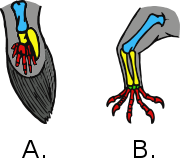Homology (biology)

In the context of biology, homology is the existence of shared ancestry between a pair of structures, or genes, in different taxa.[1] A common example of homologous structures in evolutionary biology are the wings of bats and the arms of primates.[1] Evolutionary theory explains the existence of homologous structures adapted to different purposes as the result of descent with modification from a common ancestor.
In the context of sexual differentiation—the process of development of the differences between males and females from an undifferentiated fertilized egg — the male and female organs are homologous if they develop from the same embryonic tissue.[2] A typical example is the ovaries of female humans and the testicles of male humans.[2]
In the context of morphological differentiation, organs that developed in the same embryological manner from similar origins, such as from matching primordia in successive segments of the same organism, may be said to be homologous. Examples include the legs of a centipede, the maxillary palp and labial palp of an insect, and the spinous processes of successive vertebrae in a vertebral column. In contrast, a sesamoid bone such as the patella is not homologous to a neighbouring skeletal bone such as the femur.
Sequence homology between protein or DNA sequences is similarly defined in terms of shared ancestry. Two segments of DNA can have shared ancestry because of either a speciation event (orthologs) or a duplication event (paralogs). Homology among proteins or DNA is inferred from their sequence similarity. Significant similarity is strong evidence that two sequences are related by divergent evolution from a common ancestor. Alignments of multiple sequences are used to discover the homologous regions.
Etymology
The word homology, coined in about 1656, derives from the Greek ὁμόλογος homologos from ὁμός homos "same" and λόγος logos "relation".[3][4][lower-alpha 1]
Definition
Homology is the relationship between biological structures or sequences that are derived from a common ancestor. Homologous traits of organisms are therefore explained by descent from a common ancestor. The opposite of homologous organs are analogous organs which do similar jobs in two taxa that were not present in the last common ancestor but rather evolved separately. An example of an analogous trait would be the wings of bats and birds, which evolved independently in each lineage separately after diverging from ancestors with forelimbs not used as wings (terrestrial mammals and theropod dinosaurs, respectively).
A structure can be homologous at one level, but only analogous at another. For example, the bird and bat wings are analogous as wings, but homologous as forelimbs because the organ served as a forearm (not a wing) in the last common ancestor of tetrapods.[7] Homology can also be described at the level of the gene. In genetics homology can refer to both the gene (DNA) and the corresponding protein product. It has been suggested that some behaviors might be homologous, based on either shared behavior across related taxa or common origins of the behavior in an individual’s development, though this remains controversial.[8]
Anatomical homology

Evolutionary ancestry means that structures evolved from some structure in a common ancestor; for example, the wings of bats and the arms of primates are homologous in this sense. Developmental ancestry means that structures arose from the same tissue in embryonal development; the ovaries of female humans and the testicles of male humans are homologous in this sense.
In evolutionary developmental biology (evo-devo), homology can also be partial. New structures can evolve through the combination of multiple developmental pathways, or parts of them. As a result, hybrid or mosaic structures can evolve that exhibit partial homologies. For example, certain compound leaves of flowering plants are partially homologous both to leaves and shoots because their development has evolved from a combination of leaf and shoot development.[9][10]
Determining homology
Systematists identify two forms of homology: primary homology is that initially conjectured by a researcher based on similar structure or anatomical connections, who states a hypothesis that two characters share an ancestry; secondary homology is implied by parsimony analysis, where a character that only occurs once on a tree is taken to be homologous.[11] As implied in this definition, many cladists consider homology to be synonymous with synapomorphy, a shared derived character or trait state that distinguishes a clade from other organisms.[12]
Homologous structures in other phyla
Introductory discussions of homology commonly limit themselves to the limbs of tetrapod vertebrates, occasionally touching on other structures, such as modified teeth as in whales and elephants. Homologies provide the fundamental basis for all biological classification, although some may be highly counter-intuitive. The embryonic body segments (somites) of different arthropod taxa are an example:[13]
| Somite | Trilobite | Spider (Chelicerata) |
Centipede (Uniramia) |
Insect (Uniramia) |
Shrimp (Crustacea) |
|---|---|---|---|---|---|
| 1 | antennae | chelicerae (jaws and fangs) | antennae | antennae | 1st antennae |
| 2 | 1st legs | pedipalps | - | - | 2nd antennae |
| 3 | 2nd legs | 1st legs | mandibles | mandibles | mandibles (jaws) |
| 4 | 3rd legs | 2nd legs | 1st maxillae | 1st maxillae | 1st maxillae |
| 5 | 4th legs | 3rd legs | 2nd maxillae | 2nd maxillae | 2nd maxillae |
| 6 | 5th legs | 4th legs | collum (no legs) | 1st legs | 1st legs |
| 7 | 6th legs | - | 1st legs | 2nd legs | 2nd legs |
| 8 | 7th legs | - | 2nd legs | 3rd legs | 3rd legs |
| 9 | 8th legs | - | 3rd legs | - | 4th legs |
| 10 | 9th legs | - | 4th legs | - | 5th legs |
In many plants, defensive or storage structures are made by modifications of the development of primary leaves, stems, and roots.
| Primary organs | Defensive structures | Storage structures |
|---|---|---|
| Leaves | Spines | Swollen leaves (e.g. succulents) |
| Stems | Thorns | Tubers (e.g. potato), rhizomes (e.g. ginger), fleshy stems (e.g. cacti) |
| Roots | - | Root tubers (e.g. sweet potato), taproot (e.g. carrot) |
Sequence homology

Sequences are the amino acids for residues 120-180 of the proteins. Residues that are conserved across all sequences are highlighted in grey. Below the protein sequences is a key denoting conserved sequence (*), conservative mutations (:), semi-conservative mutations (.), and non-conservative mutations ( ).[14]
As with anatomical structures, sequence homology between protein or DNA sequences is defined in terms of shared ancestry. Two segments of DNA can have shared ancestry because of either a speciation event (orthologs) or a duplication event (paralogs).[15] Homology among proteins or DNA is typically inferred from their sequence similarity. Significant similarity is strong evidence that two sequences are related by divergent evolution of a common ancestor. Alignments of multiple sequences are used to indicate which regions of each sequence are homologous. Homologous proteins make up protein families and superfamilies, encoded by gene families.
Homologous sequences are orthologous if they are descended from the same ancestral sequence separated by a speciation event: when a species diverges into two separate species, the copies of a single gene in the two resulting species are said to be orthologous. Orthologs, or orthologous genes, are genes in different species that originated by vertical descent from a single gene of the last common ancestor. The term "ortholog" was coined in 1970 by the molecular evolutionist Walter Fitch.[16]
Homologous sequences are paralogous if they were created by a duplication event within the genome. For gene duplication events, if a gene in an organism is duplicated to occupy two different positions in the same genome, then the two copies are paralogous. Paralogous genes often belong to the same species. They can shape the structure of whole genomes and thus explain genome evolution to a large extent. Examples include the Homeobox (Hox) genes in animals. These genes not only underwent gene duplications within chromosomes but also whole genome duplications. As a result Hox genes in most vertebrates are clustered across multiple chromosomes with the HoxA-D clusters being the best studied.[17]
Homology between sexes and forms
The term homology is sometimes applied to reproductive structures that share a common embryonic origin, but become spectacularly different between the two sexes in the adult. Those listed below are some of the more commonly cited examples.
| Male structure | Female structure | Notes |
|---|---|---|
| prostate | skene's gland | - |
| penis | clitoris | - |
| - | uterus | homologous to eggshell-depositing organs in reptiles and birds |
| bulbourethral gland | Bartholin's gland | - |
Among insects, the stinger used by infertile female worker honey bees is a modified ovipositor and is thus homologous with ovipositors in other Hymenoptera.
Difference between homology and analogy
Homology is different from analogy, which describes the relation between characters that are apparently similar yet phylogenetically independent. The wings of a maple seed and the wings of an albatross are analogous, and perform somewhat similar functions, but not homologous (they both allow the organism to travel on the wind, but they didn't both develop from the same structure). Analogy is commonly also referred to as homoplasy (convergent evolution), which is further distinguished into parallelism, reversal, and convergence.[18][19]
Homologies across phyla
See also
Notes
- ↑ The alternative terms "homogeny" and "homogenous" were also used in the late 1800s and early 1900s. However, these terms are now archaic in biology, and the term "homogenous" is now generally found as a misspelling of the term "homogeneous" which refers to the uniformity of a mixture.[5][6]
References
- 1 2 "Homology". Encyclopædia Britannica Online. Retrieved 2013-08-30.
- 1 2 Hyde, Janet Shibley; DeLamater, John D. (June 2010), "Chapter 5" (PDF), Understanding Human Sexuality (11th ed.), New York: McGraw-Hill, p. 103, ISBN 978-0073382821
- ↑ Bower, Frederick Orpen (1906). "Plant Morphology". Congress of Arts and Science: Universal Exposition, St. Louis, 1904. Houghton, Mifflin. p. 64.
- ↑ Williams, David Malcolm; Forey, Peter L. (2004). Milestones in Systematics. CRC Press. p. 198. ISBN 0-415-28032-X.
- ↑ "homogeneous, adj.". OED Online. March 2016. Oxford University Press. http://www.oed.com/view/Entry/88045? (accessed April 09, 2016).
- ↑ "homogenous, adj.". OED Online. March 2016. Oxford University Press. http://www.oed.com/view/Entry/88055? (accessed April 09, 2016).
- ↑ Scotland, R. W. (2010). "Deep homology: A view from systematics". BioEssays. 32 (5): 438–449. doi:10.1002/bies.200900175. PMID 20394064.
- ↑ Moore, David S (2013). "Importing the homology concept from biology into developmental psychology". Developmental Psychobiology. 55 (1): 13–21. doi:10.1002/dev.21015. PMID 22711075.
- ↑ Sattler R (1984). "Homology — a continuing challenge". Systematic Botany. 9 (4): 382–94. doi:10.2307/2418787. JSTOR 2418787.
- ↑ Sattler, R. (1994). "Homology, homeosis, and process morphology in plants". In Hall, Brian Keith. Homology: the hierarchical basis of comparative biology. Academic Press. pp. 423–75. ISBN 0-12-319583-7.
- ↑ Pinna, M. C. C. (1991). "Concepts and Tests of Homology in the Cladistic Paradigm". Cladistics. 7 (4): 367–394. doi:10.1111/j.1096-0031.1991.tb00045.x.
- ↑ Page, Roderick D.M.; Holmes, Edward C. (2009). Molecular Evolution: A Phylogenetic Approach. John Wiley & Sons. ISBN 978-1-4443-1336-9.
- ↑ Brusca, R.C. & Brusca, G.J. 1990. Invertebrates. Sinauer Associates, Sunderland.: [i]-xviii, 1-922., P. 669
- ↑ "Clustal FAQ #Symbols". Clustal. Retrieved 8 December 2014.
- ↑ Koonin EV (2005). "Orthologs, paralogs, and evolutionary genomics". Annual Review of Genetics. 39: 309–38. doi:10.1146/annurev.genet.39.073003.114725. PMID 16285863.
- ↑ Fitch WM (June 1970). "Distinguishing homologous from analogous proteins". Systematic Zoology. 19 (2): 99–113. doi:10.2307/2412448. PMID 5449325.
- ↑ Zakany, Jozsef; Duboule, Denis (2007-08-01). "The role of Hox genes during vertebrate limb development". Current Opinion in Genetics & Development. 17 (4): 359–366. doi:10.1016/j.gde.2007.05.011. ISSN 0959-437X. PMID 17644373.
- ↑ Cf. Butler, A. B.: Homology and Homoplasty. In: Squire, Larry R. (Ed.): Encyclopedia of Neuroscience, Academic Press, 2009, pp. 1195–1199.
- ↑ "Homologous structure vs. analogous structure: What is the difference?". Retrieved 27 September 2016.
Further reading
| Wikimedia Commons has media related to Homology. |
- Carroll, Sean B. (2006). Endless Forms Most Beautiful. New York: W.W. Norton & Co. ISBN 0-297-85094-6.
- Carroll, Sean B. (2006). The making of the fittest: DNA and the ultimate forensic record of evolution. New York: W.W. Norton & Co. ISBN 0-393-06163-9.
- DePinna, M.C. (1991). "Concepts and tests of homology in the cladistic paradigm". Cladistics. 7 (4): 367–94. doi:10.1111/j.1096-0031.1991.tb00045.x.
- Dewey, C.N.; Pachter, L. (April 2006). "Evolution at the nucleotide level: the problem of multiple whole-genome alignment". Human Molecular Genetics. 15 (Spec No 1): R51–6. doi:10.1093/hmg/ddl056. PMID 16651369.
- Fitch, W.M. (May 2000). "Homology a personal view on some of the problems". Trends in Genetics. 16 (5): 227–31. doi:10.1016/S0168-9525(00)02005-9. PMID 10782117.
- Gegenbaur, G. (1898). Vergleichende Anatomie der Wirbelthiere... Leipzig.
- Haeckel, Е. (1866). Generelle Morphologie der Organismen. Bd 1-2. Вerlin.
- Owen, R. (1847). On the archetype and homologies of the vertebrate skeleton. London.
- Mindell D.P., Meyer A. (2001). "Homology evolving" (PDF). Trends in Ecology and Evolution. 16 (8): 434–40. doi:10.1016/S0169-5347(01)02206-6.
- Kuzniar, A.; van Ham, R.C.; Pongor, S.; Leunissen, J.A. (November 2008). "The quest for orthologs: finding the corresponding gene across genomes". Trends Genet. 24 (11): 539–51. doi:10.1016/j.tig.2008.08.009. PMID 18819722.
External links
- Brigandt, Ingo (2011) "Essay: Homology." In: The Embryo Project Encyclopedia. ISSN 1940-5030. http://embryo.asu.edu/handle/10776/1754
